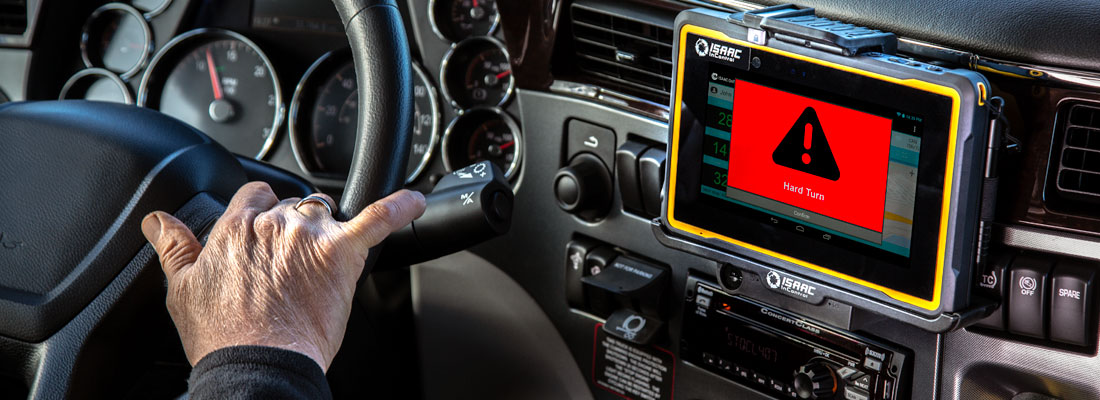Choose a Device Designed for the Trucking Industry
It’s no secret that distracted driving is one of the most common causes of collisions. Besides lives lost, injuries suffered, and collateral damage, the costs incurred can be tremendous. The cost of a fatal accident can reach 10.9 million dollars. Over the past few years, the omnipresence of smartphones has changed both our lifestyles and driving habits. Reading and sending text messages while driving ranks among the most disturbing distractions. When traveling at a speed of 110 km/h, looking away from the road to focus on a cell phone, even for 5 seconds, is equivalent to traveling the length of a football field with your eyes closed. It’s no surprise that Canadian provinces have implemented legislative measures regarding cell phone use and distracted driving.
Professional drivers are not exempt from this reality. They spend most of their time behind the wheel. Having them use a telematics solution on their phone or on an unsecured tablet while driving does them a grave disservice, and carries many risks. In the event of an accident, questions of liability arise if the driver was using a cell phone. Is it the driver’s fault? Is it the employer’s fault, for requiring drivers to use unsafe tools to do their job?
As drivers have to communicate with the office and receive instructions to perform their duties, providing them with a tool that does not compromise road safety is crucial. Choose a telematics device that is developed especially for drivers to track their hours of service, communicate with dispatchers, conduct pre/post trip inspections, and check performance reports. The device should be locked while driving, solidly affixed to the dashboard, and installed in a safe location.
Opt for Real-Time Feedback
We can only change a behavior that needs improvement, if we are aware of it. Telematics helps alert drivers in real time about the sudden maneuvers they make. Some telematics systems can warn drivers of hard braking, unsafe turns, and speeding. Drivers become aware of what they have just done and can immediately adjust their driving.
If real-time feedback is insufficient to get drivers to correct their driving behavior, safety managers can then take action. Technology makes it possible to send out email alerts to inform the appropriate people of the situation. Detailed data is also collected to allow for prompt reporting that identifies hazardous drivers and/or trends within the fleet. To foster commitment to the safety culture, managers are then better able to plan individual and group training sessions.
Protect Your Drivers and Corporate Reputation
Dashboard cameras are very popular, for good reason. Drivers will agree: some situations can be hard to believe, and in the event of an accident, their word is often brought into question. With video evidence, the circumstances of an event are undisputable. As the saying goes, a picture is worth a thousand words.
Cameras integrated with a telematics solution provide even greater benefits. Since they are connected to the vehicle’s data recorder, they automatically save the 10 seconds preceding and following every critical event. As a result, the safety manager can access the video and telemetry data surrounding a hard braking event for example, to understand the context in which it occurred. How fast was the vehicle going? Where was it, exactly? Was the driver tailgating the vehicle in front? The combination of video and data can also be used as a training tool to highlight mistakes and explain appropriate behaviors.
Staying Ahead of the Pack
Knowing the condition of vehicles and ensuring their proper maintenance is important to fleet safety. If a defect on the vehicle or trailer goes unrepaired, a telematics system can alert the driver before using it. Also, an ELD that features a camera allows drivers to take pictures of defects and automatically send alerts to maintenance managers. By addressing problems quickly, you can ensure that the vehicles you send out on the road are in good condition and thus avoid potential incidents.
Renown transportation company Trimac is a perfect example of a carrier using telematics to enhance its fleet’s safety. “Trimac’s focused approach to safety and innovation has been a key factor in providing 75 years of service to our customers,” said Matt Faure, President and CEO of Trimac Transportation.
“As part of this ongoing commitment, Trimac chose ISAAC in-cab devices for our entire North American fleet following a rigorous evaluation process. This innovative technology assists our safety efforts through real-time driver coaching, telemetry and integrated text and video communications. This level of connectivity with our drivers and understanding of their work environments improves our team’s knowledge, understanding and daily decision-making,” concluded Faure.
Employees will embrace a safety culture when they are aware of the risks and understand the impact they can have practicing workplace safety. Using technology shows the company’s commitment to safety and provides the necessary tools to identify, assess, and anticipate risks.

